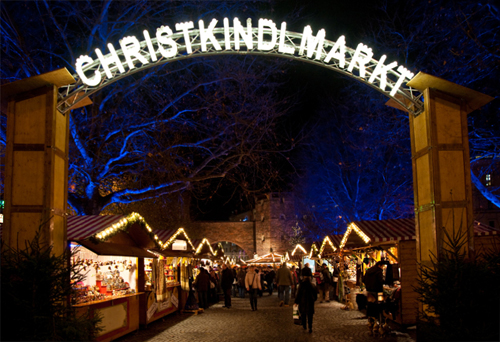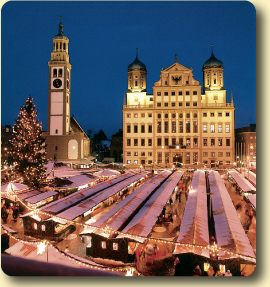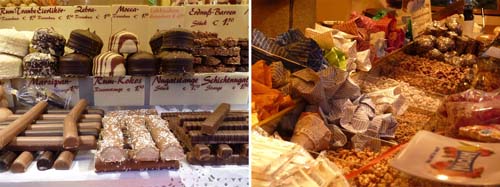Christkindlesmarkt

Christmas is a bit besieged, as I am sure you are aware. In our national compulsion to avoid making anyone feel uncomfortable, we have witnessed our institutions insist on exchanging “holiday” greetings. I certainly don’t want to offend anyone, goodness knows, and I thought about that as I downed an astonishing egg-nog that Brett whipped up behind the bar at Willow last night.
It had nothing in common with that awful stuff that comes out of the square milk cartons. This one had brandy and Meyers Rum and was subtle as a velvet hammer to the back of the head. “One,” I said. “More than that and I won’t be able to get home.”
I think the pressure to secularize Christmas is part of a larger effort to marginalize Christianity itself- they are apparently the only Great Faith that won’t fight back. So, I have been bellowing the real greeting for weeks at the least opportunity, to friends and strangers alike. I am no man of particular piety, but I think society is running up against a deep, deep well of tradition – one which I think the great majority of us are quite unwilling to part with.
I can fill myself slipping back into the dusty halls of memory, with those long departed still real, and the smells and sights of the older times so vivid. A pal wrote to give an objective view of where our current holiday came from. He said:
“English and American Puritans were not keen on Christmas, considering the celebration to represent rank Popery. Cromwell had the holiday abolished in 1647 (you can thank King Charles II for its restoration in 1660). Christmas was outlawed in Boston from 1659 to 1681 (thank Governor Andros for reversing the kill-joys). It was the influence of German settlers that caused Christmas to grow again in popularity after the American Revolution, and a German royal family – the House of Hannover – that brought it back into high fashion in England. The Victorian Christmas is pretty much an import by King George III’s wife Charlotte and Queen Victoria’s husband Prince Albert. The Victorian contribution was to make the holiday more family-centric and more private. Add a big dash of 20th century American commercialism and you have our modern Christmas celebration.”
We have a lot of Lutherans in the Socotra woodpile, and our family traditions are derived at least in part from the German school.
I recall a trip to Europe in the mid-90s to do something about the 66TH Military Intelligence Brigade in Augsburg, Germany. The unit was a “strategic” asset and hence under our GDIP funding construct, much to the dismay of the Army. We we were in the process of giving away the Kaissern to the Host Government, who was replacing the GIs with Turkish Gastarbiters (Guest Workers) which was disconcerting to us but not so much to the Germans, who by that time had become inured to occupation.
Anyway, the view into a garrison military life was fascinating- little plaques on the officer family billets with the notables who had inhabited the dwelling, descending from General Officers to simple Colonels. The houses were small, but the halls were decked in robust traditional fashion with wreathes and pine boughs and rich green garlands festooned with bright glittering decorations.
To entertain us as the northern European night arrived late in the afternoon, our host took us to the square in downtown Augsberg. The Christmas Market- or Christkindlesmarkt, as it’s known in Bavaria, is one of the oldest and most famous Christmas Markets in Germany. The Augsburg Christkindlesmarkt has been recorded in history for more than 500 years. It is set against the magnificent backdrop of the Renaissance, 16th-century, city hall, which during the advent season is turned into huge advent calendar.
Best known and most unique are the angel performances, which was one of the hooks our host used to get us to go.

Looking up, we heard the last peal of the bells in the Perlach Tower, the lights on the city hall went dark. After a few seconds, dozens of windows brightened in the beams of spotlights, and two dozen angels threw open the sashes to reveal them with wings poised as their robes swirled in the crisp wind.
Organ music swelled, and in two center windows of the town hall balcony, one angel lifted a horn, then another a flute, a third a lute, the last a harp as they “played” to the music filling the town square. Soon the sound of the instruments was joined by the voices of a children’s chorus, as the angles, bathed in soft rose and yellow lights and their heads decked with white wigs, sang along. And as the music ended, the angels stepped back and, in perfect unison, pulled shut the windows. The spotlights faded, the angels disappeared, the outer lights went bright, and it’s almost as if the several thousand residents and humble visitors like us released their breaths simultaneously in an outpouring of white mist.
We then wandered in the crisp winter air past hundreds of vendors in long covered stall selling a wide variety of gift items and Christmas decorations.

Bavarian specialties rounded out the menu, like Schupfnudeln (pinkie-shaped flour dumplings mixed with sauerkraut and bacon); Reibedutschi, (grated potato pancakes served with applesauce); and Fleischküchle, (a thick patty of chopped meat, bread, herbs and spices that may have served as a model for the American hamburger, another tradition of the Old Country).
We sipped the wonderful aromatic hot Glühwein as we wandered past the astonishing variety of foods and decorations. The Germans are serious about this stuff. It is rich and baroque and quite lovely.
Meaning no offense to anyone, I intend to observe a German-style holiday.
Merry Christmas to us all, with all the decorations.
Copyright 2013 Vic Socotra
www.vicsocotra.com
Twitter: @jayare303
